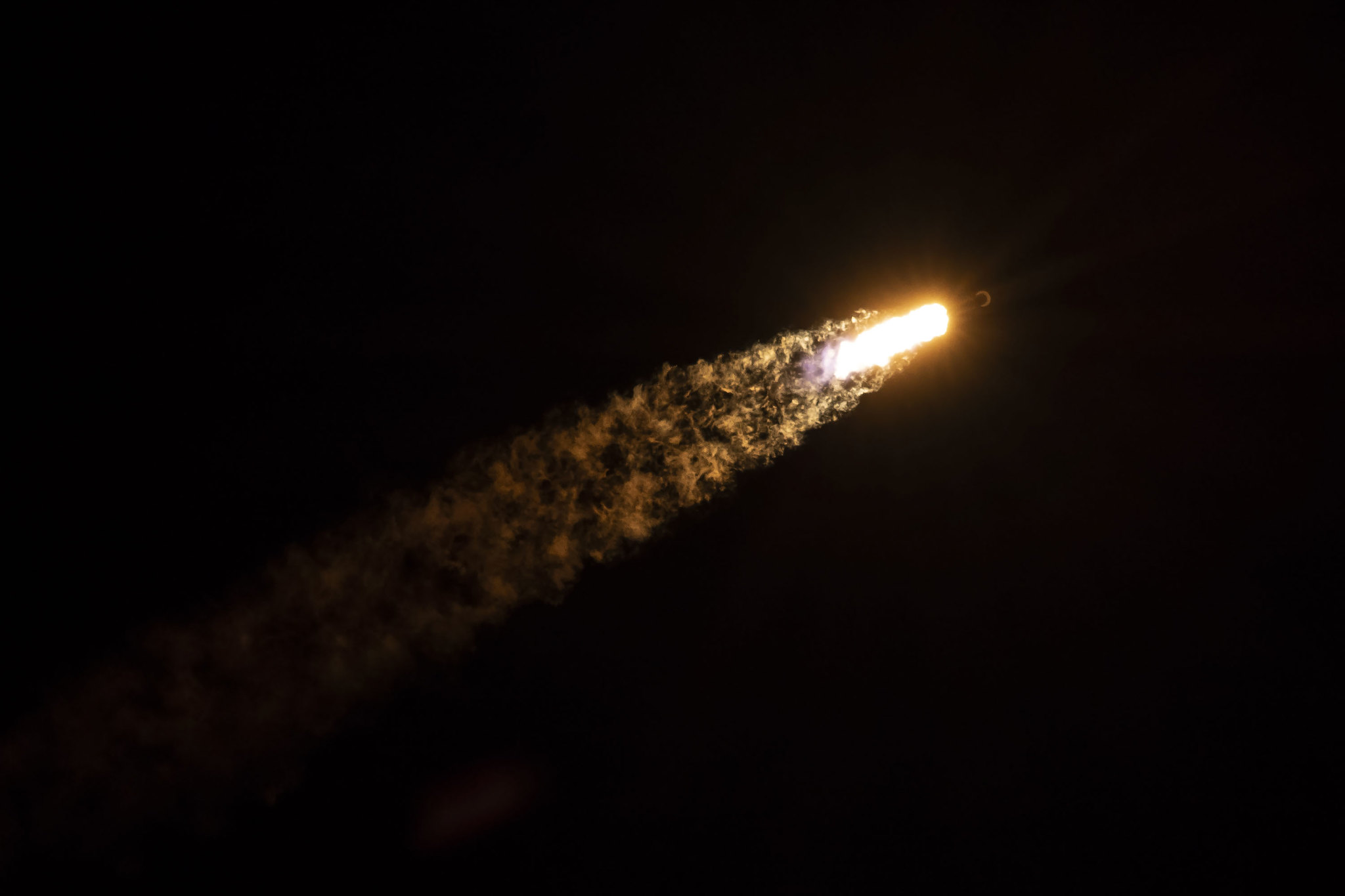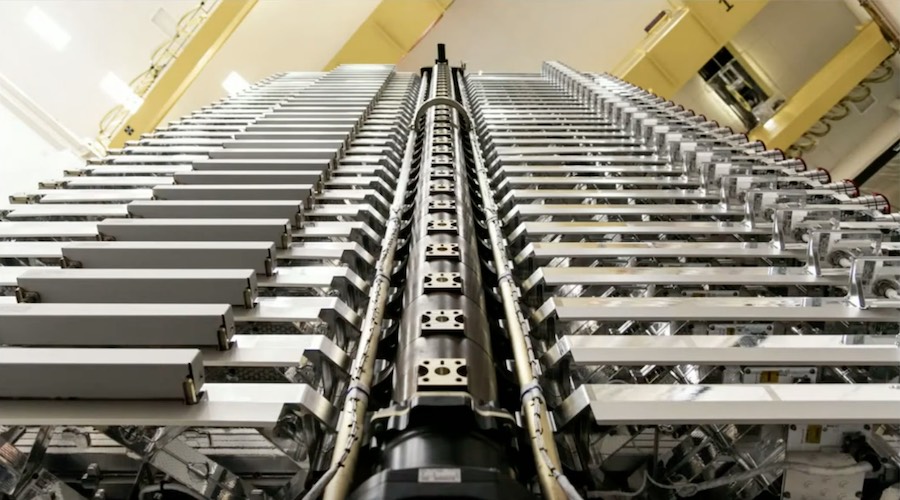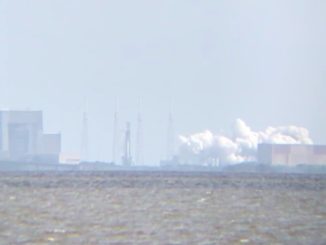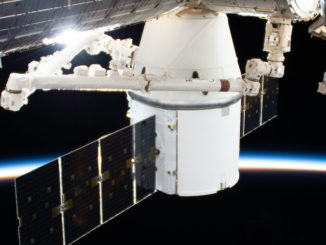
A Falcon 9 rocket and 60 more Starlink internet satellites set for launch early Sunday at Cape Canaveral will mark the first time SpaceX has flown a first stage 10 times, reaching a milestone that the company once said could be a limit for reusing boosters. Now SpaceX plans to keep flying reused rockets on Starlink missions until one fails.
The mission Sunday is set for liftoff at 2:42 a.m. EDT (0642 GMT) from pad 40 at Cape Canaveral Space Force Station, Florida. Nine kerosene-burning Merlin 1D engines will power the Falcon 9 rocket northeast from Florida’s Space Coast, following a trail blazed by 26 previous dedicated Starlink missions.
There is an 80 percent chance of good weather for launch at Cape Canaveral, according to the 45th Weather Squadron at Patrick Space Force Base. There is also a good chance of favorable upper level winds and acceptable conditions in the Falcon 9 booster’s downrange recovery area in the Atlantic Ocean.
“The overall threat for a delay looks to be small but the main weather concern for the primary day will be from the cumulus cloud rule,” forecasters wrote Saturday.
The flight Sunday will mark the 14th launch of a Falcon 9 rocket this year, and the fourth Falcon 9 mission in just 16 days.
The booster assigned to Sunday’s launch — designated B1051 — has flown to space nine times since debuting in March 2019 with the first unpiloted test flight of SpaceX’s Crew Dragon capsule. Since then, the rocket launched three Canadian Radarsat satellites, SiriusXM’s SXM 7 radio broadcasting satellite, and six Starlink missions, most recently on March 14.
The Falcon 9 booster’s 10th launch Sunday will mark the 63rd flight of a re-flown SpaceX first stage. All of the reused rocket flights to date have been successful.
When the current version of the Falcon 9 rocket — known as the Block 5 — launched for the first time in 2018, SpaceX officials said the booster could fly 10 times before requiring major refurbishment.
Elon Musk, SpaceX’s founder and CEO, said last month that the company now plans to keep flying Falcon 9 boosters until one fails. SpaceX will take that risk on missions launching the company’s own Starlink internet satellites.
“There doesn’t seem to be any obvious limit to the reusability of the vehicle,” Musk told Spaceflight Now in a press conference April 23.
Musk said SpaceX plans to keep reusing Falcon 9 boosters until they break, likely exceeding the 10-flight milestone.
“We do intend to fly the Falcon 9 booster until we see some kind of a failure with the Starlink missions, obviously, just to have that be a life leader,” Musk said.
Since launching the first reused Falcon 9 first stage on a mission in 2017, SpaceX has cinched agreements with all of its customers to fly payloads on recycled rockets.
One of the last customers SpaceX got to agree to launch on reused boosters was NASA’s commercial crew program. SpaceX’s most recent launch with astronauts April 23 was the first commercial crew mission to take off on a previously-flown rocket.
The U.S. Space Force plans to launch a national security payload on a reused Falcon 9 booster for the first time in June.
“You probably don’t want to be on a life leader for a crewed mission, but it’s probably good to have a flight or two under its belt, for the booster to have flown once or twice,” Musk said. “If it was an aircraft coming out of the factory, you’d want the aircraft to probably have gone through a test flight or two before you put passengers on.
“So I think that’s probably a couple of flights is a good number for a crew booster, and in the meantime, we’ll keep flying the life leader,” Musk said. “We’ve got nine flights on one of the boosters. We’re going to have a 10th flight soon with a Starlink mission.”

SpaceX has been using its fleet of Falcon 9 boosters to launch Starlink missions at an average pace of three times per month so far this year. On some of those missions, SpaceX has used reused first stages that set new records for their number of flights.
The most recent Falcon 9 launch Tuesday employed a booster making its ninth flight, tying B1051’s flight history until it makes its 10th launch Sunday.
Last year, a SpaceX manager said it costs less than $30 million to fly a Falcon 9 rocket with reused parts, such as the booster and payload fairing, the clamshell-like aero-structure that protects sensitive satellite payloads during the climb through the atmosphere.
Although SpaceX has proven it can safely reuse first stages, payload shrouds, and Dragon capsules, the Falcon 9 rocket’s upper stage remains a single-use component. None of SpaceX’s competitors in the commercial launch industry have successfully re-flown an orbital-class booster. Some companies, like Blue Origin and Rocket Lab, plan to eventually recover and reuse their rocket boosters.
Repeating a mantra he’s consistently said for decades, Musk said last week that reusing rockets is a “fundamental holy grail breakthrough” needed to revolutionize access to space.
“To make humanity a truly space-faring civilization, we must have a fully and rapidly reusable rocket,” Musk said in a webcast last month hosted by the X Prize Foundation. “We’ve made some progress in that direction with Falcon 9, where the booster is reusable, and the Dragon spacecraft — the upper portion — is reusable. But the Falcon 9’s second stage and Dragon’s unpressurized trunk are not reusable.
“And I would not say the Falcon booster, spacecraft, and fairing, they aren’t rapidly reusable,” Musk said. “It takes a fair bit of effort, much less effort than the space shuttle took.”
He said SpaceX refurbishment teams at Cape Canaveral can reduce the turnaround time between Falcon 9 booster flights to less than a month. So far, the shortest time between two flights of the same Falcon 9 booster has been 27 days.
Most Falcon 9 missions require the first stage booster to land on an offshore drone ship a few hundred miles downrange from the launch site. On some missions carrying lighter payloads, the booster has enough propellant reserved to turn around and fly back to the launch site for a landing onshore.
“Landing out to sea, and then having to bring it back, and then taking a month or so to get it ready for launch, I wouldn’t call that rapid by aircraft standards,” Musk said.
SpaceX’s next-generation Starship vehicle is designed to be fully and rapidly reusable, further driving down launch costs, according to Musk.
The first stage booster, known as the Super Heavy, will land back on the ground minutes after launch, similar to the profile pioneered by the Falcon 9 rocket. The Starship will propel itself into Earth orbit, and eventually to destinations in deep space, then re-enter the atmosphere at the end of its mission for a vertical rocket-assisted landing.
The entire Starship rocket stack will stand nearly 400 feet (120 meters) tall, with 28 methane-fueled Raptor engines on the first stage and six more Raptor powerplants on the Starship upper stage.
NASA awarded SpaceX a $2.9 billion contract April 16 to develop a derivative of the Starship vehicle to land the next astronauts on the Moon through the agency’s Artemis exploration program.
A NASA-owned Orion crew capsule launched on top of the space agency’s powerful Space Launch System rocket will transport the astronauts between the Earth and lunar orbit, where the crew will dock with the waiting unoccupied Starship to head to the surface of the Moon.
Under NASA’s flight plans, the Starship will launch the astronauts back into space to meet with the Orion capsule for return to Earth.
Despite using engines flown on NASA’s retired reusable space shuttles, each of NASA’s SLS rockets is designed for one flight. NASA plans to refurbish and reuse Orion crew capsules after splashing down at sea.
But the lunar mission is just part of SpaceX’s ambition for the Starship program. The rocket could launch massive clusters of small satellites, such as Starlink spacecraft, loft huge space telescopes, and carry large numbers of people to space. SpaceX says it can deliver payloads of more than 100 metric tons, or 220,000 pounds, or low Earth orbit.
“With Starship, we’ll hopefully reuse the whole thing,” Musk said. “This is a hard problem for rockets, that’s for sure. It’s taken us, we’re like 19 years in now. I think the Starship design can work. It’s just, it’s a hard thing to solve, and the support of NASA is very much appreciated in this regard. I think it’s going to work.”
“I’d say it’s only recently though that I feel that full and rapid reusability can be accomplished,” Musk said. “I wasn’t sure for a long time, but I am sure now.”
With the 60 satellites poised to blast off Sunday, SpaceX will have launched 1,625 Starlink internet satellites on 29 rocket flights, including 27 dedicated Falcon 9 missions. Some of those satellites are now decommissioned.
SpaceX has regulatory approval from the Federal Communications Commission to launch and operate 12,000 broadband satellites to provide high-speed, low-latency internet signals to consumers around the world. The network is already providing limited internet service to subscribers who have signed up for beta testing.
Email the author.
Follow Stephen Clark on Twitter: @StephenClark1.



